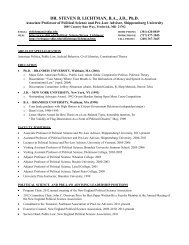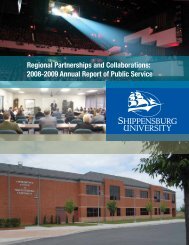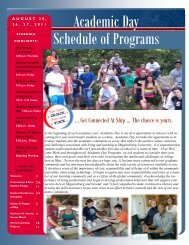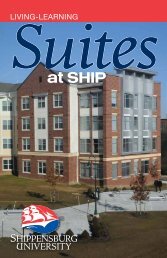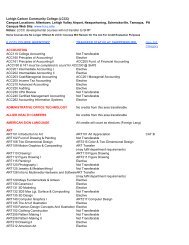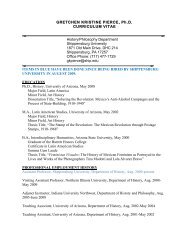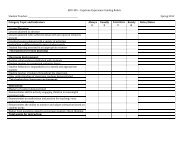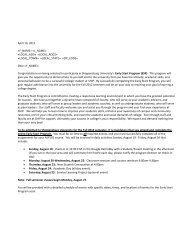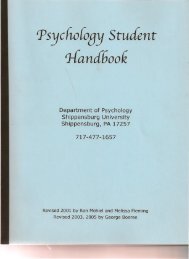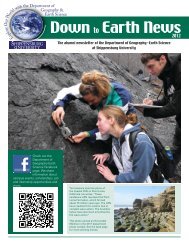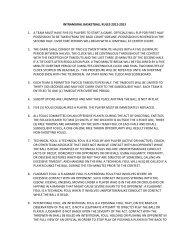Complete Issue - Shippensburg University
Complete Issue - Shippensburg University
Complete Issue - Shippensburg University
- No tags were found...
You also want an ePaper? Increase the reach of your titles
YUMPU automatically turns print PDFs into web optimized ePapers that Google loves.
Mark D. Solomon: Winters in Salmon Country 41claims appealed from his brother-in-law’s court. Asthe court could not unseat their new colleague, JusticeEismann, they unseated Wood to preserve the ethicalstanding of the court.SettlementIn the year prior to Wood’s ruling against theinstream flow claims, the State of Idaho and the NezPerce tribe agreed to enter mediation in an attempt tosettle the tribe’s Winters claims. Six years later, withappeal of Wood’s ruling stayed at the Idaho SupremeCourt, the tribe, state, and the federal government(acting in its capacity as trustee for the tribe), agreed tosettle the tribe’s instream flow claims out-of-court for amixture of instream flow rights, regulatory protectionsfor endangered species, monetary awards, and othermeasures. 35 The State of Idaho, acting on behalf of itswater rights holders, agreed to send water downstreamto support the salmon so vital to the survival of the NezPerce people. The federal government agreed to providefunding for the settlement and to enter into jointoperating agreements for federal fish hatcheries in thetribe’s Clearwater River basin homeland.In 1994, the dispersed non-treaty bands of theNez Perce partnered with the National Park Serviceto honor their Wallowa homeland with the creationof an interpretive center at Wallowa Lake. 36 In 1997,the on-reservation descendants of the treaty bands,utilizing funds granted to the tribe to offset the damagedone to the reservation and their treaty fishing rightsby the construction of Dworshak Dam on the northfork of the Clearwater River, purchased 10,300 acresof Chief Joseph band’s ancestral homeland in theWallowa country. (Another five thousand acres weresubsequently added to the tribe’s holdings in JosephCanyon.) While the land sales contain covenantsrestricting the use of the lands to fishing and wildlifepurposes, 37 for the first time in 130 years, the Nez Percepeople, “treaty” and “non-treaty”, were to some extent,home in the heart of their ancestral lands.Could There Have Been a Different Outcome?If the Pacific Northwest is defined as “wherever thesalmon can get to,” as Tim Egan writes in his 1990book, The Good Rain, then Twin Falls and Lapwaiare worlds apart. Shoshone Falls, one of two naturalsalmon-blocking cataracts on the Snake River thatgives the city of Twin Falls its name, historicallymarked that regional boundary until man-made damsstarted moving the boundary further and furtherdownstream to its present location at the base of IdahoPower Company’s Hells Canyon Dam. Shoshone Fallsno longer flows at its thundering pace, the waters of theSnake River dammed and diverted above the falls intoa thousand miles of canals delivering water to desertsoil for farming. The people who settled here, whoturned the water onto their fields to build an irrigatedagricultural empire, have never had salmon as thecenter of their lives. They and those who followed themacross southern Idaho’s Snake River plain- taking thesalmon’s water so they could live —did not then and donot now live in the Pacific Northwest Egan describes.The Nez Perce people do, and have done so sincetime immemorial. Salmon are for them both a physicaland a sacred being, offering themselves for the goodof the Nez Perce people, to sustain them in body andsoul. Most of the salmon’s range in what we now callIdaho is Nez Perce aboriginal land. As recognized inthe treaties the Nez Perce negotiated with the UnitedStates government, they could somehow accept andlive on a fraction of their former lands, but they couldnot and would not live without the salmon. Thetreaties specifically retained to the Nez Perce the rightto fish at all their usual and accustomed places. Buttoday, the salmon are killed by passage through andaround the eight mainstem dams on the lower Snakeand Columbia rivers that stand between Idaho andthe Pacific Ocean. Those that survive the passage areconfronted by headwater streams often dewatered ordegraded by agriculture, grazing, mining, logging, andurban use. The salmon are struggling to continue tooffer themselves to the Nez Perce, and the Nez Percepeople are struggling to rebuild the salmon’s Idahohome.Whether the Nez Perce could have prevented theirconquest by EuroAmericans will never be known.Their choices were constrained by the pressure of whitesettlement on their lands and the body blow to theirstrength as a people delivered by an epidemic of deadlydiseases to which the Indians had no resistance. Thedivisions that grew within the Nez Perce people as theytried to adapt to these overwhelming forces made theirtask even more difficult as different bands were forcedin separate directions by their acceptance or rejection oftreaties, culture and religion. Federal policies of tribalassimilation and termination that threatened the tribe’svery existence persisted until the 1970s.A new era for the Nez Perce and the otherColumbia River tribes began with the 1974 Boldtdecision affirming the Columbia River tribes right tohalf the salmon fishery. 38 Shortly thereafter, the gateswere closed at the Army Corps of Engineers 700-foothigh Dworshak Dam across the north fork of theClearwater River on the Nez Perce reservation. Tocompensate the tribe for the harm Dworshak Damcaused to the tribe’s fishing and hunting rights, thefederal government agreed to a mitigation plan. Theprovision of funding to implement the plan had anintentional objective—to provide resources for thetribe to help struggling salmon populations throughhabitat restoration and hatchery programs—and anunintentional (for the Corps) byproduct: enabling theNez Perce to more actively advocate for their treatyrights and by connection, the salmon.



